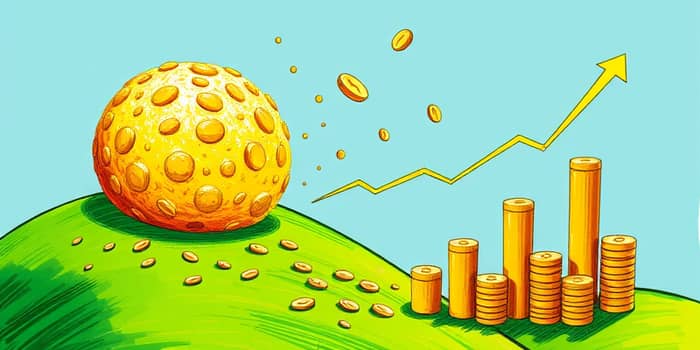In the journey toward financial freedom, few concepts rival the transformative power of compound interest. By understanding how small, consistent actions can snowball into massive outcomes, anyone can harness this phenomenon to build lasting wealth. This article explores definitions, mechanisms, mathematical principles, real-world examples, strategies, and pitfalls—arming you with the knowledge to unleash the full might of compounding.
What is Compound Interest?
At its core, compound interest refers to interest calculated not just on the original principal but also on accumulated interest from previous periods. This interest on interest mechanism creates exponential growth in value over time. Unlike simple interest—which applies only to the initial principal—compounding accelerates gains as each cycle adds new earnings back into the balance.
Often described as a snowball effect, compounding starts slowly but gathers momentum, making the later years dramatically more productive. By reinvesting earnings, your balance expands at an ever-increasing rate—turning modest contributions into impressive sums if granted enough time.
How Is Compound Interest Calculated?
The standard formula for compound interest is:
A = P (1 + r/n)n t
Here, P is the principal, r is the annual interest rate, n is the number of compounding periods per year, t is time in years, and A is the final amount. As either r, n, or t increases, the growth accelerates markedly.
For instance, invest $1,000 at 5% annual interest, compounded once per year. After one year, the value is $1,050; after two years, it becomes $1,102.50. By year ten, the same $1,000 surpasses $1,628—demonstrating how compounding magnifies returns.
The Difference Between Simple and Compound Interest
While both simple and compound interest reward savers, their outcomes diverge significantly. Simple interest pays only on the principal, leading to linear growth. Compound interest pays on both principal and earned interest, creating a curve that rises ever more steeply.
This seemingly small difference expands dramatically over longer horizons, illustrating why compounding is the superior choice for wealth accumulation.
The Snowball Effect: Why Time Matters More Than Amount
In the world of compounding, time is the most important variable. A small investment begun early can dwarf a larger investment started late simply because it has more cycles to grow. For example, saving $500 per month at a 7% annual rate over 40 years yields nearly $1.2 million. Conversely, the same monthly contribution for just 20 years would produce a fraction of that total.
Even $100 per month saved at 4% for 30 years can grow to almost $70,000—transforming household change into significant capital through patient persistence.
Legendary Endorsements and Quotes
Albert Einstein is often credited with calling compound interest the “eighth wonder of the world,” famously noting that “he who understands it, earns it; he who doesn’t, pays it.” Though the attribution is debated, the sentiment captures compounding’s transformational potential.
Warren Buffett, one of history’s greatest investors, leveraged compounding from childhood. His disciplined, long-term approach illustrates how consistent reinvestment and patience can produce extraordinary wealth, even from modest beginnings.
Accounts That Let Your Wealth Compound
- Savings accounts with daily or monthly compounding frequency
- High-yield online savings and money market accounts
- Certificates of deposit (CDs) with reinvestment options
- Retirement plans (401(k), IRA) that automatically reinvest dividends
- Index funds and dividend-reinvestment equity portfolios
Selecting products with frequent compounding and competitive rates maximizes your gains. Even small rate differences can translate into tens of thousands of dollars over multi-decade horizons.
Compounding in Investing vs. Borrowing
- Investing: Positive compounding accelerates growth in savings, retirement accounts, and portfolio values.
- Borrowing: High-interest loans and credit cards compound against you, inflating debt burdens rapidly.
Understanding this dual nature is crucial: you want compounding on your side, not working against you. Always aim to eliminate high-interest debt before embarking on aggressive investment strategies.
Risks: The Dark Side of Compound Interest
While compounding can multiply your gains, it can also magnify losses or debts. Credit card balances, unpaid loans, and interest on unpaid student debt grow explosively under compounding. A 20% annual credit card interest rate can double unpaid balances in less than four years.
Mitigation strategies include prioritizing high-interest debt repayment, consolidating loans, and avoiding unnecessary borrowing. Keeping your financial health in check ensures compounding remains an ally.
Simple Steps to Maximize Your Compounding Potential
- Start early—even small sums benefit from long horizons.
- Maintain consistent contributions by automating deposits or investment transfers.
- Avoid withdrawals to preserve the compounding engine.
- Choose accounts with higher compounding frequencies.
- Reinvest dividends and interest without fail.
Adopting these practices transforms routine savings into powerful wealth engines. The discipline to stay the course, even during market downturns, amplifies returns over decades.
Tools for Visualization: Calculators and Projections
Many financial websites and institutions offer free compound interest calculators. These interactive tools let you input principal, rate, frequency, and time to project future balances. Visualizing the growth curve can be a powerful motivator, making the abstract principle tangible and personal.
Real-Life Success Stories and Data
Consider two examples. First, contributing $500 monthly into a diversified index fund yielding 7% per year for 40 years results in nearly $1.2 million. Second, saving just $100 per month at a 4% return for 30 years yields approximately $70,000—enough to fund travel, education, or seed new investments.
These numbers underscore how compounding democratizes wealth-building: you don’t need a fortune to start, just time, patience, and consistency.
Conclusion: Embrace the Power of Time and Discipline
The art of compounding lies in leveraging start early and maintaining discipline through market ups and downs. By letting your earnings reinvest and avoiding premature withdrawals, you unlock a profound wealth-building machine. Every dollar saved today becomes tomorrow’s capital base, growing faster with each cycle.
Whether your goal is a comfortable retirement, a dream home, or financial independence, understanding and applying compound interest can turn incremental actions into monumental results. Embrace this timeless principle, and watch your financial future blossom beyond imagination.
References
- https://utxcu.com/how-to-use-compound-interest-to-build-wealth/
- https://www.nasaa.org/investor-education/young-adult-money-mission/compound-interest-2/
- https://www.key.com/personal/financial-wellness/articles/building-wealth-with-compound-interest.html
- https://www.wealthenhancement.com/blog/what-is-compound-interest
- https://www.carterwealth.com/insights/the-power-of-compound-interest-a-simple-path-to-wealth/
- https://www.kiplinger.com/kiplinger-advisor-collective/compound-interest-turns-small-investments-into-big-wealth
- https://www.juliusbaer.com/en/insights/wealth-insights/how-to-invest/compound-interest-the-engine-of-wealth-creation/
- https://www.wellsfargo.com/financial-education/investing/compound-interest-growth/










